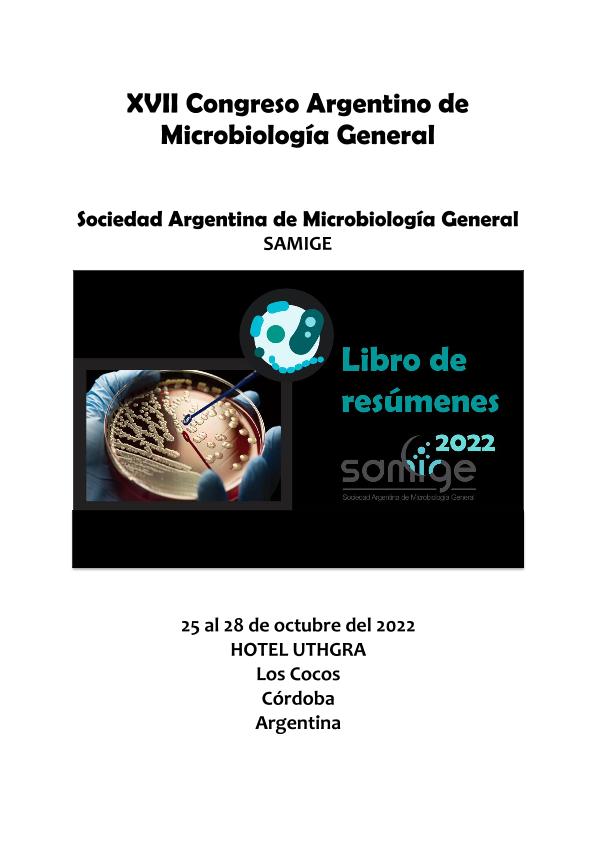Evento
Bioremediation of lindane and chrome (vi) co-contaminated soils by bioaugmentation with an indigenous consortium of actinobacteria
Tipo del evento:
Congreso
Nombre del evento:
XVIII Congreso Argentino de Microbiología General
Fecha del evento:
25/10/2022
Institución Organizadora:
Sociedad Argentina de Microbiología General;
Título del Libro:
Libro de Resúmenes del XVII Congreso Argentino de Microbiología General
Editorial:
Sociedad Argentina de Microbiología General
Idioma:
Inglés
Clasificación temática:
Resumen
The technological advances and the growth of the world population have created severe problems of mixed contamination in soils, by both organic and inorganic compounds. In particular, mixed pollution by chromium VI [Cr(VI)] and lindane (LIN) has been reported in different environments around the world, including the Northwest of Argentina.The treatment of co-contaminated soils is complex and presents numerous challenges. Bioremediation is a promising technology that could successfully remove mixed compounds.Bioaugmentation with actinobacteria represents an efficient biotechnological tool for the mixed polluted soil reclamation.The objective of the present work was to remove simultaneously LIN and Cr(VI) from silty loam soils, by the bioaugmentation with an actinobacteria consortium formed by Streptomyces sp. M7, MC1, A5, and Amycolatopsis tucumanensis AB0. Mesocosmos of 1 Kg of soil were prepared, contaminated with both pollutants and allowed to stabilize for a month at room temperature and 50% of water holding capacity. They were then inoculated at 0 and 30 d with the actinobacteria consortium (2 g Kg-1, each strain in the same proportion). Mesocosms were incubated for 90 d with minimal intervention of environmental parameters. All corresponding controls were carried out.The contaminated system (CS), did not remove LIN until the end of the assay; however, the contaminated and bioaugmented system (CBS) showed 80% removal of the pesticide during 90 d of incubation. Both CS and CBS were able to remove almost all Cr(VI), however, CBS could do it faster and more efficiently.The microbial counts (MC) showed an inhibitory effect of the contaminants on the native flora of the soil, since the lowest MC were observed in CS (8.7 x 10 7 UFC g-1), which were significantly lower at the end of assay respect to 0 d (1.44 x 10 8 CFU g-1). The highest MC were reached in bioaugmented systems (BS) (1.6 x 10 9 CFU g-1), which showed a growing profile up to 40 d of incubation and remained constant until the end of the assay. The natural soil (NS), without any treatment, presented a constant profile in the MC throughout 90 d (1.70-2.71 x 10 8 UFC g-1), while the CBS showed a variable profile up to 40 d of incubation and then increased, reaching similar values to SB (1.2 x 10 9 CFU g-1).The enzymatic soil activities showed a negative effect of the contaminants on them, especially catalase, which was totally inhibited until 50 d of incubation; since then this activity was recovered, in coincidence with the greater removal of the contaminants. The fluorescein diacetate hydrolysis activity (FDA) showed a strong correlation with the MC. FDA ranged between 8.01 and 135.07 g fluorescein g-1 h-1; NS showed the lowest FDA. Acid phosphatase activity exhibited variable profiles, but following a certain correlation with the MC in all systems. The maximum value was 130.03 g p-nitrophenol g-1 h-1 in NS, whereas the lowest was observed in CS (4.29 g p-nitrophenol g-1 h-1).
Palabras clave:
BIOREMEDIATION
,
MIXED POLLUTION
,
ACTINOBACTERIA
,
MESOCOSM
Archivos asociados
Licencia
Identificadores
Colecciones
Eventos(PROIMI)
Eventos de PLANTA PILOTO DE PROC.IND.MICROBIOLOGICOS (I)
Eventos de PLANTA PILOTO DE PROC.IND.MICROBIOLOGICOS (I)
Citación
Bioremediation of lindane and chrome (vi) co-contaminated soils by bioaugmentation with an indigenous consortium of actinobacteria; XVIII Congreso Argentino de Microbiología General; Los Cocos; Argentina; 2022; 71-72
Compartir




